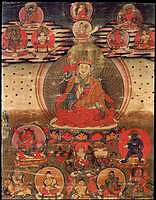
|
Guru Rinpoche Padmasambava (painting no. 74)
|

View Larger Image |
||||||||||||||
|
Guru Rinpoche Padmasambhava (Tibetan: pe ma jung ne) the bestower of wealth surrounded by a host of wealth deities. Gazing on all beings, with one face adorned with a moustache, the right hand holds to the heart the staff of a victory banner made of various coloured silks fluttering above. The left hand placed in the lap holds a brown mongoose - bestower of jewels. Adorned with gold earrings, necklace and various ornaments, the head is covered with a lotus hat of silk brocade topped with a half-vajra and feathers. Attired in various robes of different colours reflecting the disciplines of the Vinaya, Bodhisattva and Mantra Vehicles, in a relaxed manner, he sits on a sun and moon disc above a multi-coloured lotus blossom surrounded by a radiating nimbus of light spheres and a rain shower of variously coloured wishing jewels. At the top center is the buddha Shakyamuni and below that is the bodhisattva of long-life, White Tara. At the upper left is the buddha of medicine, Bhaishajaya Guru, blue in colour. Seated below is the goddess Vina Sarasvati, white, with one face and two hands, holding a stringed instrument in a crouching posture. At the left side is a green goddess with the right hand performing the mudra of generosity while holding the stem of a flower blossoming at the right side. The left is held at the heart in blessing. Seated in a relaxed fashion her right foot rests upon a gold treasure vase. At the upper right is the buddha of long life Amitayus, red, holding a long-life vase in the lap. At the lower left is red Tara, deity of power, holding a hook in the right hand and the stem of a lotus blossom to the heart with the left. To the right is the goddess of wealth Vasudhara, yellow in colour, the right hand in the mudra of generosity and the left holding a stalk of grain to the heart. Both are seated in a relaxed posture. Along the bottom are various forms of the two wealth deities Jambhala and Vaisravana. At the lower left is Red Jambhala of the Terma tradition, with three faces and six hands. At the right is Black Jambhala, popularized by Shakyasribhadra, holding a skullcup and mongoose, naked and wrathful in a standing posture. In the middle is White Jambhala of the Jowo Atisha lineage, with one face and two hands holding a stick and mongoose, riding a green dragon. At the bottom middle is Yellow Vaisravana holding a long staff in the right hand and a mongoose in the left, without the usual body armour; riding on a lion. To the right is Yellow Jambhala holding a bijapuraka fruit in the right hand and a mongoose held in the lap. To the left is Green Jambhala of the Kalachakra system, holding a fruit and mongoose, embraced by the consort green Vasudhara. At the right and left corners are two forms of Vaisravana, each with one face and two hands holding a mongoose in the left. Wearing body armour, helmets and flowing garments they ride atop sleek horses. Principal among the many teachers to bring Buddhism to Tibet in the 8th century, Guru Rinpoche had eight main manifestations and numerous other forms representing outer, inner and secret aspects. This form, a Revealed Treasure teaching (Terma), represents Guru Rinpoche as a wealth deity manifesting the attributes of Vaisravana. Within the Kama (Oral) Tradition of the Nyingmapa School, Padmasambhava was born in Northern India, possibly the Swat Valley, as the son of a king or minister. In the Terma (visionary treasure) Tradition he was born on a lotus in the middle of Dhanakosha Lake as an emanation of the Buddha Amitabha. Jeff Watt 10-98
|
|||||||||||||||
Photographed Image Copyright © 1998 Shelley & Donald Rubin Foundation
|
|
| |
Next Image |